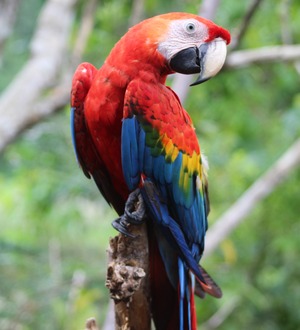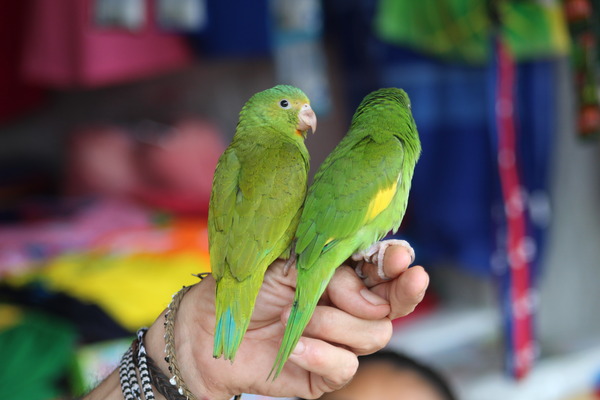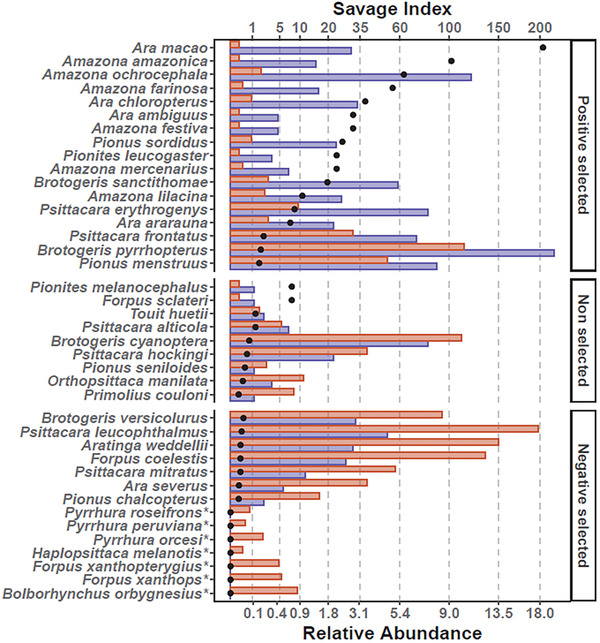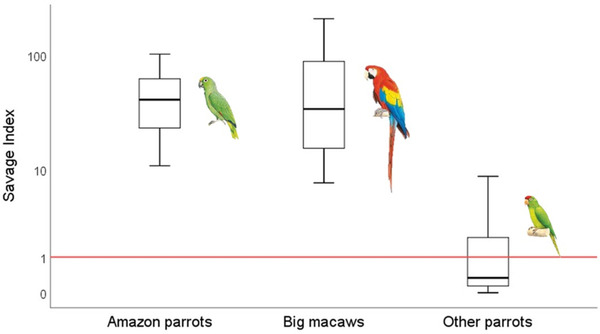 LINKED PAPER
LINKED PAPER
Poaching sources and trade routes in Peru and Ecuador warn of the unsustainable rural demand for preferred parrot species. Romero‐Vidal, P., Toledo‐González, B., Bunn, L., Blanco, G., Hiraldo, F., Bermúdez‐Cavero, A. O., Carrete, M. & Tella, J. L. 2023 Conservation Science and Practice. doi: 10.1111/csp2.12936 VIEW
Parrots are one of the most threatened avian orders, with the illegal wildlife trade being a serious conservation threat for several species (IUCN 2020). CITES (Convention on International Trade in Endangered Species of Wild Fauna and Flora) regulates the international trade in nearly all parrot species, with the most abundant species dominating the legal trade (Chan et al. 2021). In addition, other actions that have been taken at the international scale such as the U.S. and E.U. bans on importing wild-sourced individuals have led to a substitution of wild parrots for captive-bred parrots in the international parrot trade (Chan et al. 2021). However, illegal international trade persists, representing a serious threat for species in high demand.
The illegal domestic trade appears to be more concerning than the illegal international trade, especially in the Neotropics (Ortiz-von Halle 2018). Approximately 70% of Neotropical parrot populations are threatened by illegal domestic trade (Berkunsky et al. 2017). Tens of thousands of parrots are sold annually in illegal markets in countries such as Bolivia, Peru or Brazil, and these figures may be underestimating actual extraction rates, as they do not take into account high mortality during capture, transport and captivity before and after the sale of wild-caught birds (Baños-Villalba et al. 2021). Moreover, these surveys primarily focused on markets in major cities, and field studies to assess the number of parrots taken for personal use or sold by poachers in rural areas are urgently need (Romero-Vidal et al. 2020). These studies would contribute to a better understanding of the wider impacts of this overlooked threat to parrot conservation.

Figure 1 Brotogeris cyanoptera (left) and Brotogeris versicolurus (right) displayed on a store in the city of Pucallpa (Peru) to be sold © Pedro Romero-Vidal.
In our extensive study conducted in Peru and southern Ecuador, we aimed to understand the impact of local poaching on the supply of pet parrots in rural areas. Our approach involved comparing the relative abundance of parrot species in the wild with their presence as pets. By conducting road censuses, we were able to estimate parrot abundances and identify households with wild pets along the surveyed routes. We further investigated the origins of these pets by determining whether they were poached locally, transported from distant areas, or purchased in urban markets. To accomplish this, we analysed the trade routes using the available road network, tracing the journey of each individual parrot detected.

Figure 2 Study area covering Peru and southern Ecuador. Routes are represented by black lines, road-censuses are represented by red lines, and locations where wild pets were found with blue dots. Localities with markets which sell wildlife are indicated by black circles and the name of the locality.
During our study, we documented a total of 979 pet parrots belonging to 33 native species across 190 different locations, covering a wide distribution throughout the study area and the roadside surveys conducted. The majority of these parrots were obtained through local poaching, either by individuals keeping them as their own pets or by purchasing them from other local poachers, bypassing formal markets. Poachers primarily targeted chicks from nests but also captured adult parrots using traps and nets in agricultural areas. In contrast, our roadside surveys recorded 7,475 wild parrots representing 40 species. The relative abundance of parrot species in the wild varied significantly, with just 8 species accounting for 82% of all individuals observed.
The Savage Selectivity Index is an index that allows us to determine which species are preferred, based on the comparison of how abundant they are in the houses as pets with their availability in the wild. The results of this index showed a non-random poaching pressure. While the most abundant species were negatively selected, several of the uncommon species were poached more than expected (i.e., positively selected) attending to their relative abundances in the wild. Notably, species within the Amazona and Ara genera, such as Amazons and large macaws, were the most positively selected. Furthermore, pets of these highly preferred species were more likely to be concealed, not openly displayed on streets or public establishments, in comparison to other species. It is important to note that all Amazons and large macaws were poached as nestlings from their nests, whereas 24% of pets from other species were trapped as adults. These findings highlight species-specific differences in poaching practices and behaviours.

Figure 3 Poaching selection (Savage index, SI; black dots) and relative abundances (%) in the wild (red bars) and as household pets (blue bars) for each parrot species.
Pet parrots that were not obtained from formal markets were primarily sourced through local poaching within their native distribution range. However, our study also identified instances where parrots were poached from distant areas, with distances of up to 1,009.79 km. The likelihood of parrots being moved outside their native ranges increased as the selectivity index value increased. Pets poached locally had lower index values compared to those sourced from distant areas. Additionally, two macaws: Blue-and-yellow Macaw (Ara ararauna) and Scarlet Macaw (A. macao), purchased in markets were found to have been transported from Peru to Ecuador, covering considerable distances. Furthermore, positively selected species commanded higher prices in the market compared to other species. There was a discernible trend suggesting that species prices increased with their selectivity index values. Lastly, the selectivity index value exhibited a correlation with population trends, indicating that species with higher selectivity index values had declining population trends.

Figure 4 Boxplot of median selectivity indexes for amazons (genus Amazona), large macaws (genus Ara), and the other parrot species recorded as pets. The red line indicates non-selection, with values above or below 1 indicating positive or negative poaching selection.
Our findings deviate from previous studies conducted on city markets and seizures of illegally traded parrots in Peru, which showed a lower representation of preferred species. It is evident that local poaching and rural trade have significant impacts on preferred parrot species’ population trends, operating across extensive spatial scales. Addressing this unsustainable situation poses a challenge for implementing effective conservation measures aimed at curbing poaching and illegal trade. To tackle this issue, conservation efforts should prioritise vast and remote rural areas throughout the Neotropics, rather than solely focusing on well-known markets in major cities.
References
Baños-Villalba, A., Carrete, M., Tella, J. L., Blas, J., Potti, J., Camacho, C., Sega Diop, M., Marchant, T. A., Cabezas, S., & Edelaar, P. 2021. Selection on individuals of introduced species starts before the actual introduction. Evolutionary Applications 14:781-793. VIEW
Berkunsky, I. et al. 2017. Current threats faced by Neotropical parrot populations. Biological Conservation 214:278-287. VIEW
Chan, D. T. C., Poon, E. S. K., Wong, A. T. C., & Sin, S. Y. W. 2021. Global trade in parrots–influential factors of trade and implications for conservation. Global Ecology and Conservation 30:e01784. VIEW
IUCN. 2020. The IUCN red list of threatened species. Version 2020-2. VIEW
Ortiz-von Halle, B. 2018. Bird’s-eye view: Lessons from 50 years of bird trade regulation. TRAFFIC. VIEW
Romero-Vidal, P., Hiraldo, F., Rosseto, F., Blanco, G., Carrete, M., & Tella, J. L. 2020. Opportunistic or non-random wildlife crime? Attractiveness rather than abundance in the wild leads to selective parrot poaching. Diversity 12:314. VIEW
Image credit
Top right: Scarlet Macaw Ara macao © Pedro Romero-Vidal.
If you want to write about your research in #theBOUblog, then please see here.



